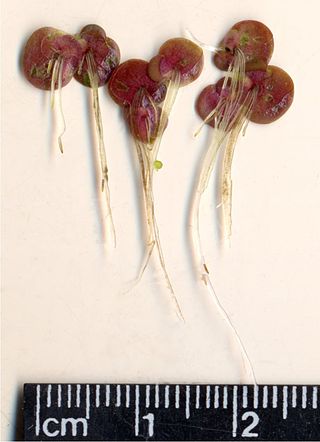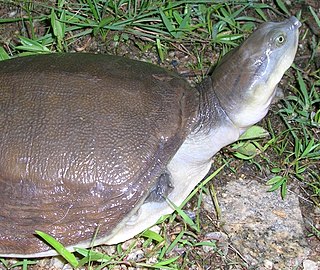
Gambusia is a large genus of viviparous fish in the family Poeciliidae. Gambusia contains over 40 species, most of which are principally found in freshwater habitats, though some species may also be found in brackish or saltwater habitats. The genus Gambusia comes from the Cuban term, "Gambusino", which means "free-lance miner". The type species is the Cuban gambusia, G. punctata. The greatest species richness is in Mexico, Texas, and the Greater Antilles, but species are also found elsewhere in the eastern and southern United States, the Bahamas, Central America, and Colombia. Gambusia species are often called topminnows, or simply gambusias; they are also known as mosquitofish, which, however, refers more specifically to two species, G. affinis and G. holbrooki, which are often introduced into ponds to eat mosquito larvae. As a consequence, they have been introduced widely outside their native range, and frequently become invasive, threatening local species. G. affinis and G. holbrooki are now established in many parts of the world and are likely to continue to spread as climatic conditions change. They are only occasionally kept in aquariums, due to their relative lack of color and the highly aggressive nature of the aforementioned mosquitofish species.

Lysimachia is a genus consisting of 193 accepted species of flowering plants traditionally classified in the family Primulaceae. Based on a molecular phylogenetic study it was transferred to the family Myrsinaceae, before this family was later merged into the Primulaceae.

Spirodela is a genus of aquatic plants, one of several genera containing plants commonly called duckweed. Spirodela species are members of the Araceae under the APG II system. They were formerly members of the Lemnaceae.

Anthemis is a genus of aromatic flowering plants in the family Asteraceae, closely related to Chamaemelum, and like that genus, known by the common name chamomile; some species are also called dog-fennel or mayweed. Anthemis are native to the Mediterranean region and southwest Asia east to Iran. A number of species have also become naturalized in the United Kingdom and other parts of the world.

Spirodela punctata is a species of duckweed (Lemnoideae). The species is morphologically intermediate between Lemna and other species of Spirodela. In 1999 D.H. Les and D.J. Crawford proposed segregating the species to a new genus Landoltia containing just the species L. punctata, on the basis of biochemical and DNA studies.

The Indian flapshell turtle is a freshwater species of turtle found in South Asia. The "flap-shelled" name stems from the presence of femoral flaps located on the plastron. These flaps of skin cover the limbs when they retract into the shell. It is unclear what protection the flaps offer against predators. Indian flapshell turtles are widespread and common in the South Asian provinces. It is morphologically an evolutionary link between the softshell and hardshell aquatic turtles. Exploitation for profit and habitat change are threats to their survival.

Phyllorhiza punctata is a species of jellyfish, also known as the floating bell, Australian spotted jellyfish, brown jellyfish or the white-spotted jellyfish. It is native to the western Pacific from Australia to Japan, but has been introduced widely elsewhere. It feeds primarily on zooplankton. P. punctata generally can reach up to 50 centimetres (20 in) in bell diameter, but in October 2007, one 72 cm (28 in) wide, perhaps the largest ever recorded, was found on Sunset Beach, North Carolina.

Lissemys is a genus of softshell turtles in the subfamily Cyclanorbinae of the family Trionychidae. The genus is indigenous to southern Asia.

Wirada is a genus of comb-footed spiders that was first described by Eugen von Keyserling in 1886.

Psychotria is a genus of flowering plants in the family Rubiaceae. It contains 1,582 species and is therefore one of the largest genera of flowering plants. The genus has a pantropical distribution and members of the genus are small understorey trees in tropical forests. Some species are endangered or facing extinction due to deforestation, especially species of central Africa and the Pacific.
Speleoperipatus is a monospecific genus of velvet worm in the Peripatidae family, containing the single species Speleoperipatus spelaeus. This species is a pale greenish yellow, almost white, with 22 or 23 pairs of legs and no eyes. Specimens range from 27 mm to 34 mm in length. The minimum number of leg pairs found in this species (22) is also the minimum number found in the neotropical Peripatidae. This velvet worm is viviparous, with mothers supplying nourishment to their embryos through a placenta.

The Noronha skink is a species of skink from the island of Fernando de Noronha off northeastern Brazil. It is covered with dark and light spots on the upperparts and is usually about 7 to 10 cm in length. The tail is long and muscular, but breaks off easily. Very common throughout Fernando de Noronha, it is an opportunistic feeder, eating both insects and plant material, including nectar from the Erythrina velutina tree, as well as other material ranging from cookie crumbs to eggs of its own species. Introduced predators such as feral cats prey on it and several parasitic worms infect it.
Trachylepis tschudii is an enigmatic skink, purportedly from Peru. First described in 1845 on the basis of a single specimen, it may be the same as the Noronha skink (T. atlantica) from Fernando de Noronha, off northeastern Brazil. T. tschudii represents one of two doubtful records of the otherwise African genus Trachylepis on mainland South America; the other is T. maculata from Guyana.

Ransoniella is a genus of sea snails, marine gastropod mollusks in the subfamily Erroneinae of the family Cypraeidae, the cowries. Most species in this genus have become a synonym of species in NotadustaSchilder, 1935

Cociella is a genus of marine ray-finned fishes belonging to the family Platycephalidae, the flatheads. These fishes are found in the Indo-Pacific region.
Spipipockia is a genus of land snails with an operculum, terrestrial troglobiont gastropod molluscs in the family Cochliopidae.
Oryza punctata is an annual grass in the rice genus Oryza, also known as red rice, related to cultivated rice O. sativa. O. punctata forms clumps or tussocks from 50–120 cm tall. It is a native to tropical Africa and Madagascar but is also found in Thailand and other parts of Indochina. O. punctata is a weed species in commercial rice growing operations although it appears to be rare in its native range. O. punctata has an IUCN status of least concern. It is not generally eaten or used as fodder by farmers but there is some evidence that it has been used as such during periods of famine. Due to the importance of the crop varieties of rice globally, the evolution of the Oryza genus as a whole has been studied extensively. A lot of information about O. punctata has been elucidated as a secondary benefit to this commercial research. O. punctata evolved some 5 million years ago in the second of two rapid radiation events that occurred in the Oryza L. genus.

Wernya is a genus of moths belonging to the subfamily Thyatirinae of the Drepanidae. It was described by Yoshimoto in 1987.

Peripatopsis alba, the white cave velvet worm, is a species of velvet worm in the family Peripatopsidae. This species has 18 pairs of clawed legs, with the last pair reduced, and no eyes. Specimens range from 32 mm to 48 mm in length. Like other velvet worms in this genus, this species exhibits matrotrophic viviparity, that is, mothers in this genus retain eggs in their uteri and supply nourishment to their embryos, but without any placenta.














